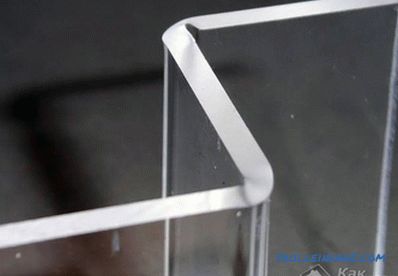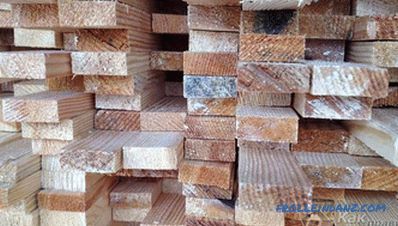Everyone knows how difficult it is to clean the walls and ceiling of the kitchen from greasy soot that inevitably remains after cooking. Mixing with dust, it forms a very unaesthetic bloom. It would seem that quite recently the repair has been made, and now everything must be repainted and re-glued again - otherwise it will be unpleasant to enter the kitchen. However, such a situation may arise if only traditional ventilation systems are used to clean the air.
Now, with the invention of the kitchen hood, repairs in the kitchen may not be necessary for a long time. The device does not allow grease to settle on the walls or cabinets with a ceiling, catches smells and any evaporation. The air in the apartment remains clean and fresh. So buy a hood, if you do not already have it, definitely worth it. This article will tell you how to choose the hood for the kitchen correctly, without being lost in the variety of models. In it we will talk about the main characteristics of the hoods and how their various modifications differ from each other.
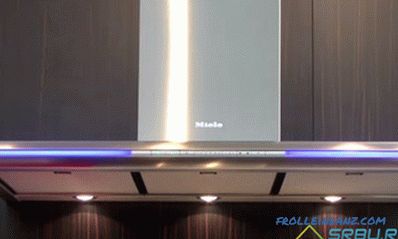
For what the
hood serves and how it works The device works on the principle of forced ventilation. It removes combustion products from the air, as well as odors and fumes. But in the kitchen, when you cook, neither smells nor splashing fat can not be avoided.
Inside the hood, there is a system of special filters that traps evaporation, odors and soot. In addition, it has a forced ventilation system. All this is enclosed in a case on which the control panel is located, either of electronic or mechanical type. Depending on how air is cleaned, exhaust can be of the following two types:
1. The recirculation hoods clean the polluted air with filters and then release it back into the room.
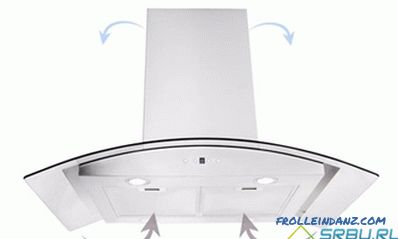
An example of a recirculation hood and how it works.
2. Flow-type devices suck in dirty air, clean it of grease and soot, and then release it through an external ventilation system.
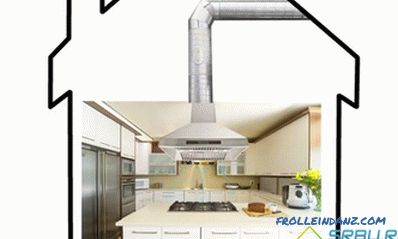
Example of a flow hood and its principle of operation.
The hood is usually fixed to the ceiling or wall above the stove. Sometimes it is hidden in a wall cabinet, open at the bottom - it looks very aesthetic. The device can be seen only specifically looking there.
As for the ceiling and wall hoods, they are made to fit perfectly into the design of the kitchen. Air purifiers attached to the wall can be made in the form of a fireplace or a neat visor. Sometimes in such a visor there is a retractable screen with a filter inside.
By what criteria should you choose the hood
So, how to choose the right hood for the kitchen and what to pay attention to first? Let's answer this question.
Filter system
In devices of recirculation type, the cleaned air passes through two stages of filtration. At the same time, some filters eliminate extraneous odors, while oily particles along with soot settle on others.
1. The oily particulate filtering system can be a removable plastic cassette with a synthetic winterizer or non-woven fabric attached to it. This filter is disposable. As it gets dirty, you can pull it out by inserting a new one.
There are reusable aluminum or steel filters - they are not removed, but are periodically cleaned of dirt.
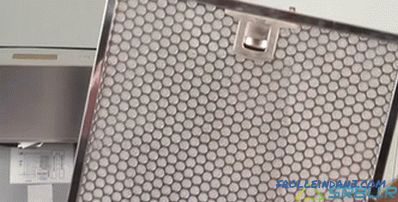
In the photo is a reusable metal filter.
2. In addition, disposable carbon filters are used with the help of which various odors are neutralized.
It should be noted that almost every kitchen hood can be adapted to the recirculation mode. In this case, not to do without grease filter. But the second stage of filtration is not urgently needed, without it the exhaust hood will work tolerably well in recycling mode. If you do not use the grease filter, all the oil and grease will fall on the fan blades and the internal parts of the exhaust device. And from there, to remove stuck fat and soot is a laborious task.
Some low-end models of air purifiers even work without filters — they simply remove contaminated air through external ventilation. At the same time due to the pressure difference to the place of the removed air comes clean, from the street. Such devices on sale are quite rare.
It is better to pay attention to modern models of extracts, which both unpleasant smell and fat will remove in 6-8 minutes. Moreover, the air will lose at least 96% of excess impurities. This is especially important in those apartments where the kitchen and dining room are not separated.
Appearance and design of the hood
Now consider how to choose the hood for the kitchen, depending on its design. Surely you have asked yourself this question. After all, these household appliances are suspended, made in the form of a dome, as well as insular. There are also models that have a working panel extending. Let's characterize all these kinds of devices.
1. Suspended hoods are the cheapest and easiest to install, so they are popular with customers. Their mode of operation is recirculation, with reusable filters being used. They are characterized by low cost and simple installation.
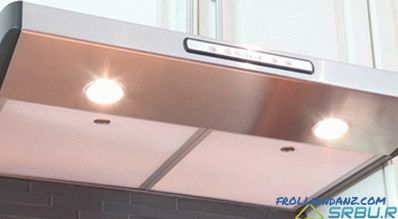
Suspended hood, which is good to use in those rooms where there is no possibility of exhausting air into the ventilation.
2. Dome hoods resemble an umbrella in their shape. Their second name is mantel. They are also mounted on the wall above the stove, and can work not only in the recirculation mode, but also in the flow-through mode.
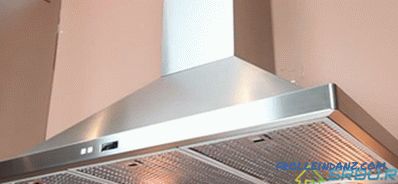
A dome-type hood is connected to the room ventilation system and cleans the air very well.
3. When the stove in the kitchen is built-in, it makes sense to use an extract of the built-in type. In this case, in a special hanging cabinet with an open bottom, the exhaust device can be perfectly masked.
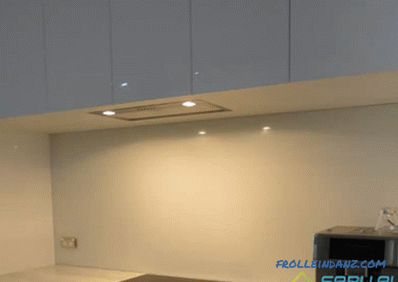
Built-in kitchen furniture.
4. And if the stove is located not near the wall, but in the middle of the kitchen room, they acquire an island-type hood. The type of work they have - flow.
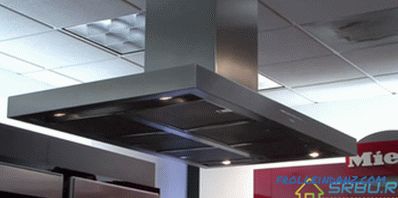
In the photo, an island hood.
5. Plus models with a retractable panel are compact in size. At the same time, by extending the panel, if necessary, it is possible to treat the air over the entire surface of the plate.
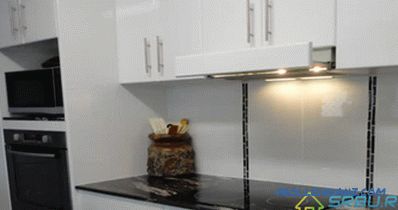
Sliding hood integrated in kitchen cabinets.
About fans and their power
There can be from one to two fans powered by electric current in the exhaust device. When talking about how to choose the power of the hood for the kitchen, have in mind the power of its fans. From this value depends on the main parameter hood - performance. It determines how much air can clean a device per unit of time. As a rule, the performance of modern exhaust devices ranges from 180 to 700 m3 / h. Fans can operate at two or four speeds.
High performance also has its downside: when the device is operating, a very noticeable noise is heard. Yes, and usually do not need to work on the limit. Is that sometimes you need to turn on the hood to the maximum - for example, when the food is burnt or the milk ran away. And if something quietly warms up under the closed lid, then the fans with a small capacity can cope with it.
There are sanitary standards, according to which, the air in the kitchen should be replaced 10 to 12 times within an hour. We do the calculation: we calculate the volume of the kitchen, subtract the volume of all the furniture from it, and then multiply by 10. As a result, we get a number that determines the desired performance of the device.
Control panel - which one is better?
There is a control panel on the outer part of the hood. It can be push-button, touch or slider type.
1. Touch control is convenient in that you just need to lightly touch the desired sector of the panel with your finger. The LED will immediately light up and the device will complete the task.
2. The slider type control panel allows you to select the desired mode using a mechanical slider that moves along the plane.
3. With buttons, everything is simple - each button on the panel corresponds to a particular device mode.
Also, the hood may have useful functions such as the off timer after a specified time, the ultrasonic humidity sensor and the electronic type speed selector. Such a switch can increase the speed of the fans if the smoke content exceeds the set value.
When you select, you can stop at the touch control, it is certainly convenient but the cost of these hoods more.
Exhaust dimensions
It is necessary to choose an exhaust device in accordance with the size of the cooker. Remember the basic rule: get a hood with dimensions not less than the cooking surface.
The standard width of kitchen stoves is from 60 to 90 centimeters. If at the same time choose the hood for the kitchen 50 cm wide, then a good result can not be achieved. It is better to let the stove be blocked by an air purification device than vice versa. And then the fat and unpleasantly smelling air, and even look, it will penetrate into the bedroom.
Now a little about the height of attachment of this device. According to the rules, above the gas stove it is necessary to hang the hood not lower than 75 centimeters from the surface. For electric stoves this distance is less - 65 centimeters. If you ignore this rule, then you can and accidentally make a fire. After all, the hood in this case will be very hot, which can lead to the burning of fat accumulated on its walls.
Connection with communications
In order for the air purifier to work well, it must be properly connected to the ventilation system. To connect you need to use short nozzles.The more elbows the duct has, the lower the exhaust performance. The calculation is simple - every bend gives a performance decrease of 5 percent.
The smoother the duct wall and the larger its diameter, the better the device will work. But the corrugated hoses, such convenient to install, on the contrary, reduce its performance.
Additional "gadgets"
In models of hoods of the highest price category, additional useful functions can be additionally present. This, in particular, "interval switching" and "residual stroke" of the fan.
Periodic activation of the exhaust device with an interval of one hour ensures a constant flow of fresh air into the apartment. In this case, the fan works on the quietest run, and the air from the room is immediately vented to the street.
"Residual stroke" implies that after shutting down the exhaust for 5, 10 or 15 minutes, her fan will work quietly. So you can achieve almost perfect purification of kitchen air, which can still be some time after cooking.
What kind of lighting is preferable
When you cook, you want the dishes to look as natural as possible. Therefore, it is best to use halogen lamps above the surface of the slab. They are not cheap, but they serve for a long time, and the products with their light will look appetizing and natural. But fluorescent lighting should not be used - it will distort the shades. Yes, and incandescent bulbs do not give, as it should, blue, yellow and red.
About the cost of kitchen hoods
In our country, stores have a wide range of budget options for hoods, as well as models of the middle and highest price categories. When deciding how to choose a hood for your kitchen, first decide how much money you are willing to spend on it. And what is the difference between models of different price categories, read on.
1. The most inexpensive hoods are made of plastic with the addition of metal parts. They are controlled by buttons or a slider, the fan has no more than three speeds, the performance does not exceed 450 m3 / h. As the lighting devices are two incandescent lamps.
2. Models of the average price are made of stainless steel, aluminum and tempered glass. The panel can be not only push-button or slider, but also touch. Sometimes there is a panel on the panel. Either incandescent lamps or halogen lamps can be used as lighting devices. The performance of the device is up to 650 m3 / h.
3. The highest performance of expensive models of hoods. Its value can reach 1300 m3 / h. As their finishing valuable wood can be used. There is a remote control, touch panel, as well as many sensors (humidity, smoke, temperature, filter pollution), which activate the device at the right time. There is a sleep timer, and only halogen lights are used for lighting.
Summary table of characteristics and recommendations
| Parameters | Values | Selection guideline |
|---|---|---|
| Filter system | Oil filtering; Coal - for filtering odors | It’s better not to buy cheap flow hoods that are not equipped with absolutely no filtration system. In general, the presence of a filter depends on the design of the hood. |
| Exhaust construction | Suspended; | It is good in those rooms where it is not possible to connect to the ventilation duct. |
| Dome; | You can use where there is a good opportunity to connect to the ventilation duct. | |
| Built-in; | If the kitchen has all the appliances and a stove built into the furniture, then it is advisable to use this hood. | |
| Ostrovnaya; | Used if the plate is not located near the wall of the room. | |
| Extendable; | Relevant for small kitchens | |
| Power | 180 to 700 m3 / h | Calculated by multiplying the volume of the room by 10 or 12. |
| Control panel | Touch; Slider; Button. | The sensor is the most convenient, but only expensive models are supplied with it. |
| Overall dimensions | 50 - 90 cm. | It is selected in accordance with the size of the stove. |
| Additional functions | Intermittent. | Choose this function depending on your needs. |
| Residual move. | Allows you to clear the air after cooking. |
Video: Choosing a kitchen hood
